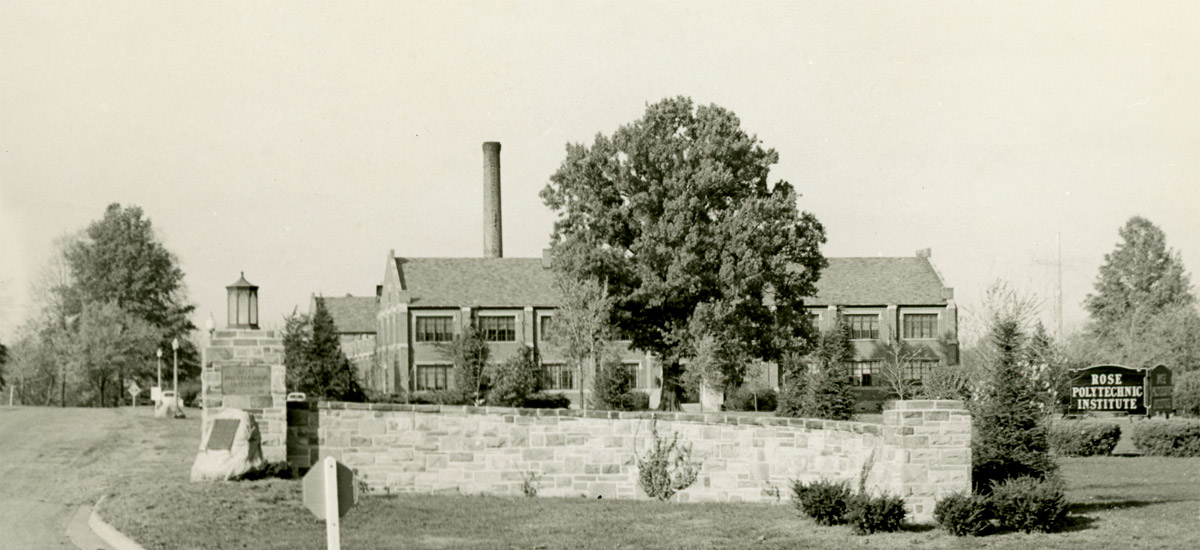William Pickett and John Robson, Copyright © August 1998.
One central purpose has guided Rose-Hulman Institute of Technology since its founding more than a century ago. In the words of President Samuel F. Hulbert, "the Institute's fundamental objective is to develop students academically, culturally, physically, and socially so that they can make significant contributions to the nation's economy, the resolution of social problems, and the welfare of human race."
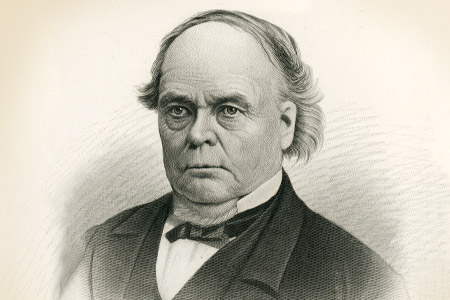
This objective reflects the purposes and philosophy of the founder, Chauncey Rose, a Connecticut native of Scottish descent who came to western Indiana in 1817. A businessman, entrepreneur, builder of railroads, leading citizen and philanthropist, Rose and nine of his friends on September 10, 1874, established a corporation and articles of association aimed at creating and maintaining "The Terre Haute School of Industrial Science," an institution chartered under the laws of the State of Indiana "for the intellectual and practical education of young men." A Board of Managers consisting of Mr. Rose and his associates administered the school.
Under a Board of Managers consisting of Mr. Rose and nine of his trusted friends, the articles of incorporation were adopted on September 10, 1874. The cornerstone of the original building was laid at Thirteenth and Locust Streets in Terre Haute on January 11, 1875. Simultaneously, despite Mr. Rose's protests, the Board of Managers changed the name of the school to Rose Polytechnic Institute. Because of money issues and difficulties in creating a physical plant and staff, candidates for admission were not examined and selected until March 6, 1883. Opening day for instruction took place on March 7, 1883 for a class of twenty-five. By 1903 Rose Polytechnic had over 200 male students enrolled in five major engineering curricula: Mechanical, Civil, Electrical, Architectural, and Chemistry [sic]. No dormitories existed. Students lived in rooming houses in town and took their meals where they lived, at restaurants, or in "eating clubs."
From the beginning, academic standards were rigorous. The Board of Managers was fortunate to have persuaded Dr. Charles O. Thompson of the Free Institute of Technology at Worcester, Massachusetts, to become president of the new institute. The plan of instruction at the "first private engineering college west of the Alleghenies" thus followed the excellent pattern of that eastern institution. As Dr. Thompson stated in his inaugural address: "the engineer is distinct from the artisan or craftsman by exactly the amount of his knowledge of the scientific principles which underlie the practice of his profession." He thus insisted on a balance of theoretical and practical work. Along with firm grounding in mathematics and physical science, the faculty required students to take courses in foreign languages (German, Spanish, and French). The seniors had to prepare a thesis based on independent work and defend it before a committee of faculty and outside examiners. Within a few years, requirements for admission included four years of high school work.
Perhaps the most dedicated and respected member of the faculty in the early years was Dr. Carl Leo Mees (pronounced MACE). After graduating from Ohio State University at 18 years of age, he four years later received the degree of doctor of medicine. He then studied physical science in London and Berlin, followed by five years as professor of physics and chemistry at Ohio State University. He came Rose in 1886 as adjunct professor of physics. He soon advanced to the rank of professor, served twice as acting president, and in 1895 became president, remaining in that post twenty-four years, until 1919 -- longer than any other man in institute history to that time.
But those years were not easy ones. Rose Polytechnic Institute sometimes found itself short of cash and during these times it was only the force of Mees' character and personality that persuaded the best faculty not to accept offers to go elsewhere. Professor John B. Peddle recalled that Mees' "most outstanding trait was his vast sympathy with others, and he used this with striking effect in the management of students. He could look upon both sides of any question and then by the use of common sense methods would make the student see and accept his point of view. . . . His unselfish devotion to the school was proverbial." Alumni from that era later recounted that "the Doctor" even cared for the health of individual students -- an extra task for which his medical education and experience qualified him.
In 1917, the campus at Thirteenth and Locust having become too small for an enrollment that was nearing 300, the Hulman family of Terre Haute donated its 123-acre farm, east on U.S. 40 just outside the city limits to the institute. Just five years later construction of a new campus began on the former Hulman property. The cornerstone of the 80,600-square-foot main classroom building was laid on September 13, 1922. The Board then authorized construction of Deming Hall, the first student residence, so that first-year students who were not Terre Haute residents could live on campus. Despite increased enrollment and the large new facilities, the institute retained its intimate flavor. The staff, in 1924, consisted only of the president, 17 faculty members (a student faculty ratio of 17:1), an athletic coach, bursar, registrar, librarian, and the secretary to the president.
Student life always was lively. A variety of student clubs, musical organizations, and publications existed. Social fraternities included Alpha Tau Omega, chartered in 1893; Sigma Nu in 1895; PIES (later Theta Kappa Nu, then Lambda Chi Alpha) in 1900, and Theta Xi in 1907. In 1901, the students wanted to have a football team. Athletics were so popular that the faculty felt it needed to establish limits. They allowed football but only after the students agreed to have no more than two practices a week and one game per weekend. By 1906, the faculty became more lenient, permitted students who were members of athletic teams to be excused from classes at 4 p.m. and ruled that all classes should end at 5 p.m.
The institute prided itself on the moral character of its students. Nevertheless, as one might expect, "high jinks" were not unknown. Townspeople would gather to witness the annual "pipe rush," a challenge baseball game to which freshmen were invited by the sophomores, but told (according to one poster from the time), "Leave your pipes with your nurses." At some point in the game, the freshmen would all suddenly produce their forbidden pipes, resulting in an instant free for-all-that continued until all the offending articles were wrested from them. These struggles occasionally got out of hand and broken noses and arms were common. After the 1931 St. Patrick's Day dance, the entire student body was forbidden social events for the remainder of the year.
During the period from 1900 to 1961, the school changed little and the enrollment grew only slightly, remaining generally between 300 and 400. Exceptions occurred during the two world wars, when large groups of army recruits arrived to receive training in such subjects as vehicle maintenance. After World War II, Rose also received students attending on the GI Bill® of Rights and with the addition of temporary barracks housing, operated on a year-round basis until 1951. Construction on campus during the period included an athletic field house--named for its architect, Wilbur Shook, Rose Polytechnic class of 1911--in 1948 (using as its frame a war-surplus B-29 hanger); a student center in 1954; and a second dormitory in 1956. Degree programs in mathematics, physics, and chemistry were added in 1958.
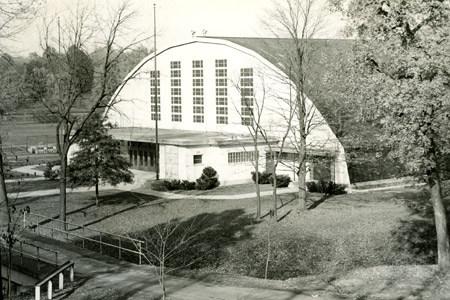
With Dr. John A. Logan's accession to the presidency in 1962, dramatic changes began. An internationally-recognized civil and environmental engineer who had supervised the eradication of malaria-carrying mosquitoes in Brazil and Sardinia, he was aware of a growing need for engineers and knew that a larger student population would more easily absorb the costs of the changes needed on campus. He thus persuaded the Board of Managers to increase the student body to 1,000 (a goal that was reached in 1969). The Board also increased the number of faculty and doubled starting salary levels for the various ranks.
The campus facilities expanded during the 1960's and 1970's to include four new dormitories, married student apartments, and three social fraternities--Triangle, Phi Gamma Delta, and Delta Sigma Phi--at the east end of the campus. The Hulman Foundation provided a gift for construction of the Hulman Union in 1966. The Board then authorized remodeling of the old student building into the Templeton Administration Building in 1969; the addition of Crapo Hall, a classroom/computer-center to the main building in 1970; the John A. Logan Library in 1974; and the E. E. Black Recreation center (since demolished, along with Shook Field House), in 1975.
In 1971, Anton Hulman, Jr. and his wife, Mary Fendrich Hulman, continuing their family's tradition of philanthropy toward the school, turned over to the institute the assets of their foundation, accumulated over the years from their respective family's fortunes in the Hulman food processing and distribution business, the Fendrich cigar manufacturing business, and from their ownership of the Indianapolis 500-mile speedway. The Board of Managers, in recognition of the receipt of Hulman assets then valued in excess of 11 million dollars as well as the many other contributions over the years of the Hulman family, decided to change the school's name to Rose-Hulman institute of Technology.
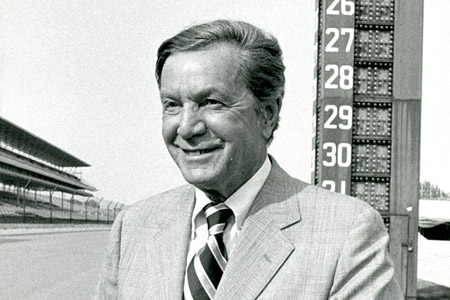
The growth of the institute accelerated under the presidency of Dr. Samuel F. Hulbert, another internationally-known teacher-scholar, this time in the field of bio-engineering, who succeeded Logan in 1976. After an extensive study of the institute by a commission of the faculty and Board, Hulbert embarked on a capital fund drive entitled "Blueprint for Excellence" which included a proposal to The Franklin W. Olin Foundation that resulted in a $4.75 million grant for a new classroom/laboratory building. Construction of Olin Hall began in 1983, and shortly thereafter the George Hadley family provided funds for a new administration building, Hadley Hall. The Board of Managers then decided to modernize all the institute's teaching facilities, ordering a renovation of the main building, renamed Moench Hall in honor of the longest-serving and most-respected faculty member of the twentieth century, the late senior vice president and professor of electrical engineering, Herman A. Moench.
It is perhaps not surprising, considering the above, that the institute in recent years has acquired an international recognition for excellence. Beginning in the mid-1980's it became one of the leading recipients in the nation of equipment grants from the National Science Foundation and was ranked by U.S. News & World Report magazine--along with Cooper Union and Harvey Mudd--as among the top three undergraduate engineering colleges in the nation. Meanwhile, it established exchange relationships with universities in Germany, Russia, Ireland, Japan, and China; initiated academic programs in applied optics, engineering management, and bio-medical engineering; and became a national leader in the use of computer-based learning (it was one of the first engineering colleges to require that all students purchase their own laptop computers) and in the assessment of educational outcomes. Responding to demand from its constituencies, including faculty and students, it also became coeducational. After continual and sometimes heated deliberations for more than a decade, the Board of Managers in 1991 voted to admit qualified freshman students on the basis of merit without regard to gender. In the years immediately following the transition, which occurred in 1995, women's fraternities (they were formed as women's fraternities, not sororities) Delta, Delta, Delta and Chi Omega colonized the campus.
In this same period, the Board inaugurated a $100-million capital campaign. Entitled "The Vision to be the Best," it reached its goal in half the expected time of ten years and resulted in the expansion of the Hulman Union, and four new structures: the large Sports and Recreation Center (to replace Shook field house), a new football stadium (Cook Stadium), the Olin Advanced Learning Center, and--thanks to a grant from the U.S. Department of Energy--the Myers Center for Technological Research with Industry. By 1997, the total assets of the institute had increased, with the value of the physical property and equipment, to $158 million. The endowment surpassed $130 million; and annual gift income--with 40% of Rose-Hulman alumni contributing to the institute's annual campaign--rose to more than $11 million.
The institute, as indicated above, was a creature of a free enterprise economy and political democracy and continues to uphold these values. Chauncey Rose had seen the need in his railroad business for employees who could use science for practical purposes. But the institute, from its inception--in addition to its high regard for technical skills and in the tradition of its philanthropist founder--has responded to society's need for professionals: energetic, skilled, confident, creative individuals aware of their obligations, not just to themselves and their employers, but also as citizens, to their country and the world. This was expressed in the tradition of the main classroom building within which all academic departments, both technological and liberal arts, were under one roof and reflected in the institute's emphasis on the humanities and social sciences, which make up 20% of the student's curriculum.
While Rose-Hulman in recent years increased in size--the student population (including graduate and off-campus programs) reaching 1,650 in 1997 and faculty numbering 113-- its character as a small college dedicated to high quality undergraduate education has remained intact. The student-faculty ratio is 15:1 so that undergraduate students are taught by faculty who hold the Ph.D. degree. Even the President teaches at least two classes a year. Its freshmen traditionally have had the highest SAT scores in Indiana and its graduates have received starting salaries above the median for engineering students in the country. Its graduates take positions in industry, some rising in management, and others start their own companies. Still others embark on careers in teaching, medicine, law, or public service.
The special qualities of the institute were expressed a few years ago by President Hulbert. Rose-Hulman institute of Technology, he said, "is dedicated to improving the welfare of mankind through its contribution to the career development of engineers and scientists. Its graduates must be problem solvers. The institute's fundamental objective is to develop them academically, physically, and socially so that they can make significant contributions to the nation's economy, the resolution of its social problems, and the welfare of mankind. Craftsmanship is obviously more expensive than mass production, but the institute believes that education on an individualized basis is the only way to develop a student to his or her maximum potential. To achieve the above-mentioned objectives, Rose-Hulman thus strives to do the following uniquely well:
- Provide a liberal undergraduate education that balances science and engineering with humanistic studies, while emphasizing the importance of clear speaking and writing.
- Provide excellent teaching and personal counseling by a faculty concerned about the individual progress and career development of every student.
- Provide a physical environment which has been carefully planned as an ideal setting in which students can mature, both technologically and aesthetically.
- Provide a broad range of extracurricular activities and encourage full participation in the life of the institute so that students will cultivate a variety of extracurricular interests and abilities.
- Provide encouragement for development of moral character and strengthening of religious faith.
- Emphasize the importance of work, honesty, patriotism, and initiative.
- Emphasize that motivation is essential to success.
- Exemplify the belief that the free enterprise system's best hope is the talent of the individual rather than the consensus of a bureaucracy.
Adherence to these values has kept the institute strong for over a hundred-twenty-five years. With a clear mission, careful financial management, a dedicated faculty, and an outstanding student body, Rose-Hulman can move forward confidently at a time when many educational institutions are having to re-evaluate their missions, because of self-doubt, fiscal crisis, and loss of students."
Something About Samuel F. Hulbert
Hulbert's parents were loving but hard working and God-fearing, their main concern the raising healthy and happy children, and of course keeping a roof over their heads. Sam's earliest memories were of rising early to milk the cows, feed the pigs and chickens, chop wood, and deliver eggs. Every spring in those early days, the family tapped maple trees and boiled the sap to make syrup, which they sold. And after moving to town, he worked with his father each morning, delivering milk in the family pick-up truck, the quart bottles in their wire crates covered with ice--something that took four or five hours every day of the week except Sunday. [worked five, I, pp. 1-2] The schedule was unrelenting and, in such a small community, provided a regular but only modest income.
Sam recalled that their house was nice enough but that they did not own a car like the families of most of his friends. When they went someplace the family had to cram into the pick-up truck. He also recalled delivering the milk at a run, to shorten the time. Of course, without realizing it, he also built stamina. [milk del., II, p. 5] What he learned in the process of this activity, was that people must earn a living, something that involved hard work, but when done properly, also was a source of satisfaction. "With hard work," he recalled his mother saying, "you can do anything."
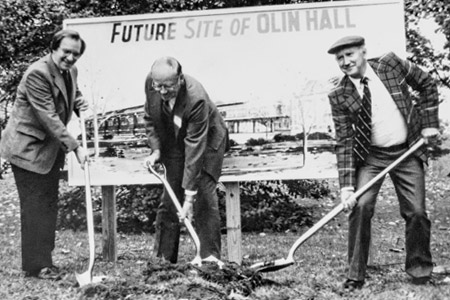
Decision On Coeducation
If one did not know the details, it is possible to assume that Rose-Hulman by the end of the twentieth century was destined to prominence in undergraduate science and engineering education. Dynamic leadership and faculty, a progressive Board of Managers, a growing and increasingly technological national economy--all these led to a major gift to the institute by the Olin Foundation in 1981 and with that came still more opportunities. Such an interpretation, although correct in broad outline, leaves out an important, perhaps even crucial part of the story-- the struggle on campus to open Rose-Hulman to female students. Indeed, it is possible that Rose-Hulman's progress would have stalled had it not been for the decision by the Board of Managers on October 3, 1991, to make the Institution coeducational. It was not an easy process, requiring over a decade of study and debate. What is notable, in retrospect, is not so much that there were winners and losers on the coed issue, but rather that both sides desired what was best for the institute and were willing to struggle for their point of view.
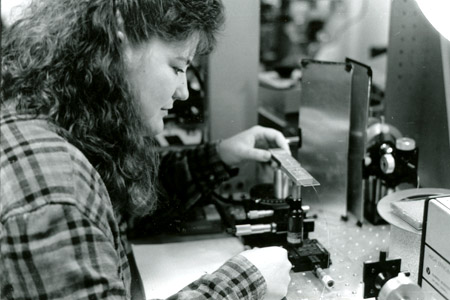
The breakthroughs in productivity came from, among other things, the savings in human labor brought by the accessibility to more and more people of the capacity to process heretofore unfeasible quantities of information. This, beginning in the mid-1980s was doubling every eighteen months (Moore's Law). In 1974, Rose-Hulman Institute of Technology had a mainframe computer but the mechanical slide rule was the basic engineering tool used by students, both in classes and after graduation. Just twelve years later, by 1986, every faculty member had a desktop computer, which cost approximately $5,000 apiece. By 1998, for almost half this cost, each student had his or her own notebook-sized "personal" computer that was a thousand times faster than 1986 desktop computers in their operation, and the amount of data it could store was measured in tens of millions, instead of hundreds of thousands of bytes. The student could carry his or her "notebook" to class; plug it into a network; and use it to do mathematical computations, construct charts, or--by clicking a handheld device called a "mouse"-- manipulate an electronic pointer on the flip-up video monitor to communicate with fellow classmates, the professor, with anyone anywhere on earth who was similarly equipped. The latter was possible because of the Internet--the on-line computer communication system of the national defense research community (a vestige of the Cold War)--now, beginning in the late 1980s, open to the public for private, educational, and commercial uses. Twenty years earlier, the world had been connected by radio, telephone, and television.
Now, individuals and institutions around the globe were in contact twenty-four hours a day via electronic mail. Indeed, anyone, such as a Rose-Hulman student, with access to a computer equipped with a modem (to connect the computer to a telephone wire) could send and receive color video and stereophonic sound as well as written messages. They could have a site, called a "home page" on the Internet's so-called Worldwide Web; or even without a site of their own, they could buy or sell things, exchange ideas, arrange travel, communicate with friends, gamble, play games, manage money, print and distribute articles and books, or, for example, retrieve historical documents from the National Archives in Washington, D.C. for a history course. Efficient, open, democratic, global markets could now exist for any idea, commodity, or device. Electro- magnetic (radio-wave) communication via a system of low, earth-orbiting communications satellites in space soon would enable individuals anywhere on earth to talk with one another (or even to send video) using wireless, hand-held (cellular) telephones or wallet-sized computers.
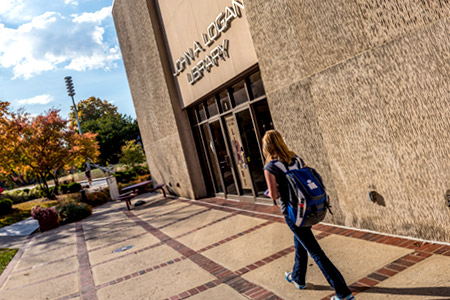
Donating to the Archives
Rose-Hulman’s Logan Library collects and maintains historical artifacts and records in its Archives & Special Collections. If you have items or information to contribute to the archives, please contact Kris Ligget.


